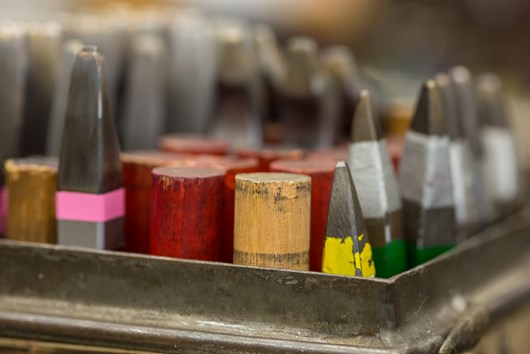
Trial of the Pyx
History of the Trial of the Pyx
Since 1871, the annual Trial of the Pyx has taken place at the Hall of the Worshipful Company of Goldsmiths, London. The Trial of the Pyx dates back to the 12th century, making it one of the longest established judicial procedures in the country.
The name Pyx refers to chests in which the coins are transported, and derives from the Latin word ‘pyxis’, meaning small box. For centuries they were stored in the Pyx Chamber in Westminster Abbey, along with other important items of state and church.
In the 13th century, the Trial of the Pyx had begun to take the form that we know today. Early trials were held first in Westminster Hall and later in the Exchequer at Westminster.

The Trial taking place in the Livery Hall, 2016
The 1870 Coinage Act established Goldsmiths' Hall as the new venue for the Trial. This made good sense as The Goldsmiths' Company Assay Office was also located in the Hall, as it is today. It is the Assay Office which has the task of testing the metallic composition of the coins.

Former Prime Warden Timothy Schroder
The Trial Today
The Trial is held annually at London’s Goldsmiths’ Hall in accordance with the Coinage Act of 1971, and is presided over by the Queen’s Remembrancer of the Royal Courts of Justice, the oldest judicial office in the UK, dating back to the twelfth century.
Little has changed in the procedure since the reign of Edward I. Throughout the year, coins are randomly selected from every batch of each denomination struck, sealed in bags containing 50 coins each, and locked away in the Pyx boxes for testing at the Trial.
The Opening of the Trial takes place at the start of each year. Officials from The Royal Mint bring chests (pyx) to Goldsmiths' Hall, containing coins put aside in the course of manufacture during the previous year. These coins, normally more than 50,000 in total, represent one coin from every batch of each denomination minted.
The trial jury, comprising members of the Goldsmiths' Company is a formal court of law. It is summoned to the Hall by the senior judge in the Royal Courts of Justice, known as the Queen's Remembrancer. During the opening proceedings the coins are counted and weighed, and a selection put aside for testing by the Assay Office. The Company has two months to test the coins.
Testing the Coinage
The purpose of the annual trial is to check that UK coins produced at The Royal Mint are within the statutory limits for metallic composition, weight and size.
The benchmark against which the coins are tested is called a Trial Plate. These metal plates, made of gold, silver, platinum and cupro-nickel, were formerly under the personal charge of the monarch in the Exchequer, and are now the responsibility of Regulatory Delivery, Department of Business, Innovation and Skills, along with the original coin Standard Weights against which the weight of the trial coins are compared.
The oldest surviving Trial Plate, now preserved in The Royal Mint museum, is of silver, dating from 1279. Trial Plates today are made from pure metals of platinum, gold, silver, copper, nickel and zinc.
Besides the annual Trial of the Pyx, rigorous quality tests are continually carried out during coin production to ensure that all coins produced at The Royal Mint conform to their correct specifications.
The Verdict
The Delivery of the Verdict, presided over by the Queen's Remembrancer, takes place three months later, after the Assay Office has verified the coins. It is attended by the Chancellor of the Exchequer (the Master of the Mint) or his representative.

Former Prime Warden William Parente at the Trial in 2015.
Chartered Trading Standards Institute’s vice-president Robert Wright was the guest of the Prime Warden and Wardens of the Worshipful Company of Goldsmiths at this year's conclusion of the Trial of the Pyx.
Read an article from TS Today - the Chartered Trading Standards Institute’s magazine for the trading standards profession - here:
